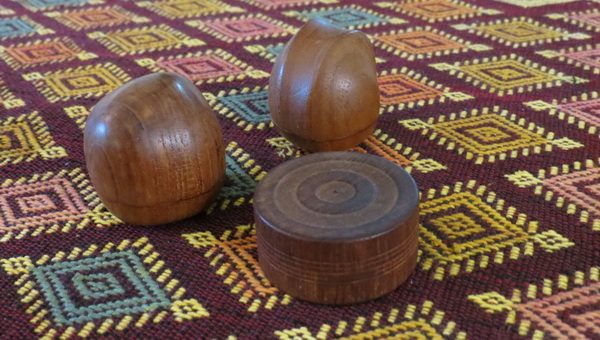Rashid addresses the issue how to go about protecting Osho memorabilia once a sannyasin who had been gifted with a present, leaves their body.

Walking down a long quiet corridor of the Victoria & Albert Museum in London recently, my companion stopped suddenly. “What is that?” I looked at her. Eyes closed she was holding her hands palm upwards as though testing for raindrops. “Something very strong,” she said.
I looked around us: high windows to the courtyard on one side, a long line of mahogany showcases on the other. They held a burglar’s dream of gold-and silverware from churches: superannuated crosses, candelabra, chalices, patens, offertory plates, etc. “Very powerful,” she reiterated. “Where’s it coming from?”
We examined the case in front of us. Mostly candlesticks and beaten gold bowls. I wandered round the back. A bunch of gold goblets, a crucifix, some dishes and a reliquary, a small chest inlaid with jewels for holding the remains of some saint. My friend joined me. “That’s him! He’s a powerful presence.”
She was sensing the energy coming from a piece of bone, or hair or clothing of a medieval saint whose reliquary she had not even seen. And this was her first visit. There is no question of the probity of this friend.
I was then, and remain to this day, awed and mystified.
It seems to me that people’s receptivity to the psychic power of certain beings and certain objects encompasses a wide and diverse spectrum. Some few can discriminate multiple energies; many millions cannot. From that inability there has arisen, both in Europe and the East, a huge, preposterous trade in holy relics – some genuine, mostly fake.
Osho gave us boxes containing his hair or nail clippings for use when needed and I have certainly felt restored and reassured by my box in times of crisis. Is it just my love for Osho that empowers the box?
Osho himself speaks of the capacity for marble to retain the energy of highly evolved beings. And he gave sannyasins his robes and hats and pens and cups, watches and jewellery, clearly not for sentimental reasons.
In the early days on the ranch, Osho would drive up the steep and winding County Road each day with Vivek beside him and, I think, Avesh up ahead in a 4-wheel drive called a Jimmy. I was with a crew of gardeners finishing off the layout and planting of the garden around his house. One momentous, ordinary day I received a radio call from Vivek some 20 minutes after they had left to say there’d been an accident. Osho would be returning immediately in the Jimmy. As he had a bad back, and as the Jimmy was very high off the ground, would I provide a means for him stepping easily down.
Bad back? That’s how we came to be in America in the first place, because of Osho’s bad back. 30 years of travelling in Indian trains, 30 years of sitting giving daily discourses is not the best thing for a body. That last year Osho’s back pain was chronic and it had been arranged for him to come to the States for specialist treatment.
We bustled around and found some concrete blocks which we arranged as steps in the few minutes before he arrived. When I opened his car door, a white-faced Vivek emerged. I stood there holding a garden rake to keep my arm as a steady handrail for Osho to lower himself down. He beamed his smile, namasted us and disappeared into his house.
Vivek later told me that Avesh had radioed back to her that one of those giant cement-mixing trucks was on its way down the narrow dirt road and Osho should pull well over to the side. Vivek said, “He did – we found a little wider space. Then you could tell, when the truck came round the bend, it was completely out of control – huge it was, with all that weight – I was totally freaked out. I looked across at Osho. He was sitting there peacefully watching the scene. The truck barrelled down on us and tore off the left side of the car.”
That week, in September or October of 1981 it must have been, my mail-order bride – we were allowed them in the early days – the mother of my two boys was coming from England. Thinking of Osho’s bad back I asked her to bring the classiest walking stick or cane that she could find for the master.
She brought one of those black-lacquered, silver knob ones that Fred Astaire needed in his top-hat-white-tie-and-tails routine. We gave it to Vivek to give to Osho.
It came to light again, two or three years later in the eloquent hands of old Swami Maitreya, the senior Indian politician who, late in his life, had dropped everything the moment he saw Osho. When Maitreya died, back in early Pune 2, a relative took the cane to the Patna area, close to the Himalayas.
Now we come to the crux of this article. Last summer, Swami Anuragi of Delhi, a high-up in a big steel conglomerate and former driver to Ma Laxmi, tracked down the cane. It was donated to his collection of Osho memorabilia, albeit with dry-rot and without the silver knob or black lacquer. He has since lovingly restored and preserved it.
Anuragi’s archive stems from love. A couple of years ago he began to feel the need to conserve, for future generations, Osho’s un-doctored first edition books. He was travelling all over India sharing his concerns with friends and, in his words, “things started coming to me. Amazing unpublished photographs, letters written by Osho, early pamphlets and so on.”
He has a meditation room in his house that now contains the full set of first editions of every Osho publication during his lifetime (before Osho’s words were reduced to cold buffet snacks in pre-digested compilations) and also robes, shoes, cups, and other items gifted by Osho to disciples.
Anuragi wants it to be known that anyone who has an item that passed through Osho’s hands and needs to be looked after with love and respect, he and his Archive would welcome it.
For me this brings into consideration what to do with items in our possession such as malas, wooden boxes and other gifts from Osho at the time of our respective deaths or inability to care for them. These objects radiate an elevated energy. I may not be able to catch the pull of a 13th century Christian saint in a museum – but I have certainly experienced the extraordinary effect of meditating in Anuragi’s sanctuary. It is like entering into Lao Tzu House in the old days. The air is thick with presence; walking in it is like wading underwater in a crystalline lake.
There is another archivist in the United States of America, Swami Champak, who has established an Osho Research and Archive Centre in Oregon (oshogalleriaor@yahoo.com). He too is an Osho lover, also a historian, educator, archivist, curator and collector. His wish is to keep alive the heart and teachings of Osho, including Osho’s work with his people. All Champak’s collecting, sharing, digitizing, exhibiting, outreach and support is voluntary and free of cost.
This too is the wish of both Swami Neeten of OSHO Source BOOK and the friends at Sannyas Wiki – they are trying, in their different ways, to get everything related to Osho up into virtual safety for all time – that includes all his words and photocopies of everything he ever wrote, schedules of his lecture tours, original artwork, film, video and photographs of him and his communes, personal stories of his people – in fact everything pertaining to Osho that later generations need to know.
And it’s also important that those who make films, documentary or feature films, or write accounts in books or essays, they too are doing the necessary work of conserving and propagating Osho’s vision. This includes Love Osho, the website of Ma Chetna and Swami Swaram, another couple who, by creating podcasts, conserve the stories of those whose lives were changed by Osho.
These guys, and many I don’t even know about, are working out of their love of Osho and the desire to share his work with the world. We are grateful to them and they are grateful for any support of much needed time and energy. Some links are below.
And of course, there’s the other side of the coin. It shocks but doesn’t surprise me that people are already creating businesses of Osho-related materials. I have grave doubts about the integrity of exploiting Osho’s connection to an object for money, be it his ashes, a mala, a robe or a piece of marble. It feels to me people are both degrading the object and themselves – throwing the baby out with the bathwater. The three core words of Osho were meditation, meditation and meditation. I feel distress and anger at those who exploit, usually with inflated prices, someone’s innocent wish to own a piece of Osho’s former bedroom or some other material aspect of his life. I hope people won’t let themselves be fooled. The purchase of a piece of marble may or may not enhance meditation but it may well enhance the ego. (Note by Osho News: unlike other items that were given to centres and individuals as gifts from Osho, the marble from his bedroom was sold by the commune to whomever wanted to buy it. After that many jewellers made pendants out of it.)
The question still remains – what will I do with my personal gifts from Osho? I think, probably the mala and box will burn with me and the remaining items go to lovers of Osho whom I love, including these archivists mentioned.
Five of my grandchildren are, as I write this, out there on the streets of London protesting the failure of governments to tackle global extinction and our climate catastrophes. If there is to be a world for future generations it will be well that the wisdom and the energy of Osho is available for the new man and the new woman.
 Rashid is a regular contributor – rashidmaxwell.com
Rashid is a regular contributor – rashidmaxwell.com
He is the author of The Only Life: Osho, Laxmi and a Journey of the Heart
All articles by this author on Osho News










Comments are closed.